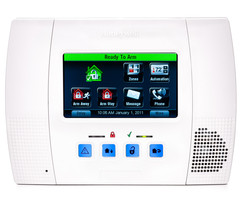What Is a Loop on the LYNX Touch L5100?
A loop is something that informs the alarm system how to act when during a triggered event. Loop settings allow a single device to behave different ways based on which loop they are programmed to. Most Honeywell wireless sensors should use the standard of loop 1 when enrolled to the L5100 Lynx Touch alarm system. Although this is the standard some wireless sensors have more than one loop and therefore break the standard rule.
For example, the 5816 is a door sensor with a dual purpose device which when set to loop 2 acts as a normal wireless door/window sensor with its included magnet. However when set to loop 1 the sensor will wirelessly transmit status of a hard wired zone connected to the internal screw terminals. This can be tricky since all other wireless sensors are set to loop1 for standard wireless reporting.
Lets also take a look at the 5821 temperature sensor since this device has both loops and physical dip switches that will affect how it reports an alarm back to the panel. This is When set to loop 1 with both dip switches off, the sensor will be set to cold temperature monitoring. The sensor will fault when the temperature drops below 45 degrees Fahrenheit for more than 10 minutes. When set to loop 2 with both dip switches off the sensor will fault when the temperature rises above 95 degrees Fahrenheit for greater than 10 minutes. When set to loop 2 with SW1 dip switch on and SW2 dip switch off the temperature sensor will fault when the temperature rises above 75 degrees Fahrenheit for more than 10 minutes. When set to loop 2 with dip switch SW1 off and SW2 dip switch you will activate freezer temperature monitoring. Simply connect the T280R temperature probe to the 5821 and string it into the freezer and if it detects temperatures above 10° F for more than 30 minutes it will trigger an alarm. If the versatility of this sensor has not shocked you yet, get ready!
When the Honeywell 470PB remote water probe is hard wired to the 5821 it will serve as a flood detector if you program another zone and set the 5821 to loop 3 with dip switch SW1 off and SW2 dip switch on. If the probe detects water for more than 3 minutes it will issue an alarm. This probe is generally positioned down in a basement near the sump pump where it tends to flood first. If you would like to report several loops or functions for a single sensor you need to program them as separate zones. Each will report independently.
The Honeywell 5816 and 5821 wireless sensors prove that loops can be functionally beneficial for getting a single piece of hardware to report several different things. Loops can be helpful in getting the most bang for your buck. However, as an end user you have to be very careful to properly program loops and position dip switches so they are reporting the proper event back to the panel.
Did you find this answer useful?
We offer alarm monitoring as low as $10 / month
Click Here to Learn MoreRelated Products


Related Categories
- Answered
- Answered By
- Frank Longo



